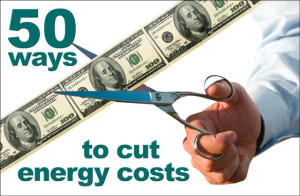Simple Strategies to Reduce Energy Consumption and Operating Costs
We all need to cut energy costs. Reducing energy consumption saves us money— and it is the right thing to do for our country and the world.
Slashing energy consumption in buildings is a great way to start conservation efforts. Buildings are a huge energy drain. Buildings suck up 40% of all energy used in America— and account for over 73% of all electricity consumed in the U.S.
 Does that shock you? It should. Even more appalling, experts estimate 30%-50% of the energy devoured by commercial buildings is wasted energy. Learn how to reduce energy consumption in buildings below.
Does that shock you? It should. Even more appalling, experts estimate 30%-50% of the energy devoured by commercial buildings is wasted energy. Learn how to reduce energy consumption in buildings below.
Conserve Energy and Cut Costs
Simple changes can reduce or eliminate wasted energy at home— and at work.
Start at the top. A white or light colored roof makes an incredible difference in energy usage. With an outside temperature of 90 degrees Fahrenheit, a white roof is 80 degrees cooler than a black roof. Light colored roofing actually last longer, too. Adding a reflective coating further cools the roof surface in hotter climates. Consider replacing roofing with highly reflective cool-coated metal roofing.
Reduce air leaks. Replace windows with high-performance windows. Seal tightly around all windows and doors.
Power down. Unplug seldom-used appliances. Use power strips for computers and peripherals and turn off the strips when not in use. Unplug battery chargers for phones, tablets, PDA’s, cameras, and other electronics when not in use. Set your computer to sleep mode, so that an inactive screen goes dark instead of wasting power with a screen saver. Invest in energy-saving electronics, office equipment, heating and air conditioning systems, and appliances when they need replacing. Look for Energy-Star rated products. Set the water heater thermostat between 120 and 130 degrees.
Light for less. Turn off lights when the room is empty. Replace your bulbs with energy-saving compact florescent light (CFL) bulbs. CFL bulbs use less electricity, produce the same amount of light, and last up to ten times longer than ordinary bulbs. Install dimmer switches to use less light in daylight hours. Use motion detecting lights outdoors, rather than continuously burning lights.
Winter comfort. Lower your home thermostat at night. Cover bare floors. Keep air vents obstruction-free. Limit use of energy-sucking portable heaters. Change heating filters monthly. Open windows and shades on sunny days. Turn on ceiling fans on low speed, turning clockwise.
Summer comfort. Raise the thermostat to 78 degrees or more. Switch the thermostat to “auto” for greater savings. Change air conditioning filters monthly— or even more often if the structure is near construction or dusty roads. Use ceiling fans, set to turn in a counter-clockwise motion. Turn ceiling fans off then no one is in the room. Add films, low-e glazing, awnings, blinds, or solar window screens to windows to reduce summer heat. Repair leaky air ducts. Add injected foam insulation to walls. Increase attic or ceiling insulation. Be sure fireplace dampers are closed. Close air vents in unused rooms.
Landscape with a purpose. Plant trees to shade the sunny side of the structure for cooler summers. Add green areas around the building to reduce the urban heat island effect.
The strategies above reduce energy costs for homeowners or business owners. The following ideas will cut energy costs for commercial and industrial buildings.
Basic building strategies. Enlist employee co-operation in reducing energy usage. Reschedule janitorial services to diminish hours of operation. Turn off all copiers and printers when not in use. Keep all equipment filters clean. Audit the building at night to see what is left on that should not be. Set thermostats to save power during off hours. Better yet, install programmable thermostats. When purchasing new equipment, look for energy ratings. Consider dimming lighting in hallways. Reduce the number of outside lights or use lower-wattage bulbs. Use more task-specific lighting at workstations, instead of brightly lighting an entire area of workers. Don’t wait until a fluorescent bulb burns out to change it; change all bulbs on a schedule. Collect your energy usage data. Track your progress. Seeing how much the strategies you choose cut energy costs will motivate you do even more to slash energy consumption.
Building Green Saves More Green
The best building way to cut energy costs in buildings is to build an energy-efficient building from the start. RHINO pre-engineered steel buildings offer many energy-saving options and features. We will explore those in our next blog.
For more information now about RHINO metal buildings, please call 940.383.9566.
